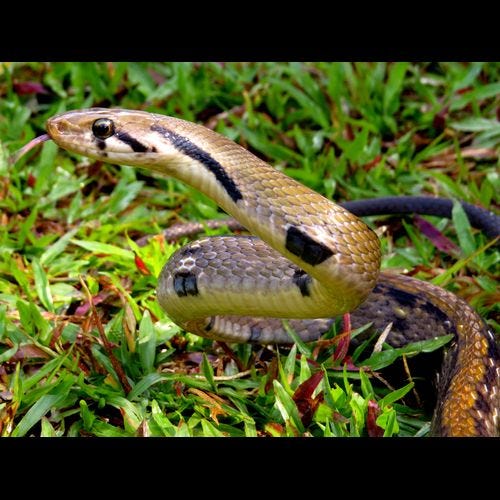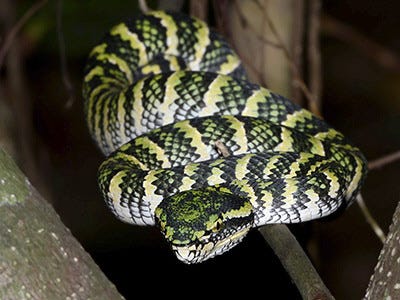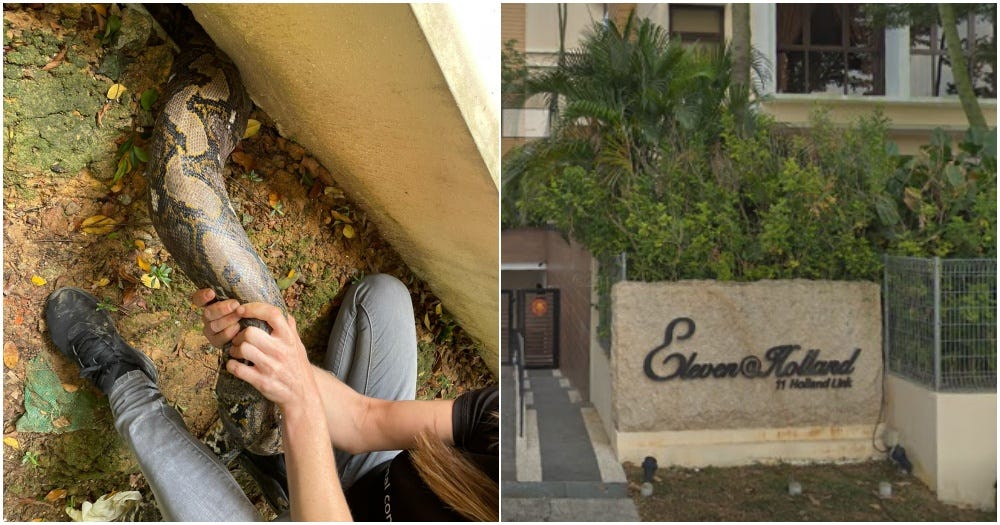Snakes of Singapore
What would you do if you came across a reticulated python during your hikes around Singapore? If you say "I'd yell and run!", maybe this newsletter will convince you to observe in awe instead.

I’ll be the first to admit that I’ve been slightly scared of snakes - maybe it’s the sinister hissing sound, or the chance of being bitten and having venom injected into my body. However, my proclivity to the reptile changed when I had the privilege of watching a talk by Sankar from the Herpetological Society of Singapore (HerpSoc if you’re like me and struggle with pronouncing multi-syllabic words) on how such creatures could even be seen as cute!
We hadn’t done many biodiversity episodes on SGExplained yet and because doing an episode on otters would be too cliché, we decided to be slightly edgy and do a whole episode on the Snakes of Singapore.
Check out the Podcast!
We were thrilled for our first guest-feature of Season 4 with Sankar from the HerpSoc coming on to share where and how he witnessed some interesting antics from the snakes of Singapore. Hear about snake fights and chance encounters, and perhaps even get convinced to go snake-spotting yourself!
The Snakes that didn’t make it to the Podcast
Before we dive into some of the other cool snakes that exist in Singapore, it’ll be useful to remind ourselves that most of these snakes are native to our land - they have existed here before we did and co-exist with us! Most times, they even function as our natural pest control, eating mice and bats that may enter our homes. Because they like to keep to themselves, the best we can do when we encounter a snake is to let it find a corner for itself and just call NParks Animal Response Centre or ACRES Wildlife Rescue Hotline. There is little need to freak out! Having established that, let’s check out some of the cool snakes that make up our biodiversity!
Dog-Toothed Cat Snake

The Dog-toothed Cat Snake (what a name!) is a nocturnal species that can be found in lowland forests, both on land and in the trees. Its body is often orange-brown to yellowish-brown, with white-edged irregular dark bars which extend from the neck to the tip of the tail. If you’re snake-spotting, you can recognise the species by the thick dark stripe behind the eye. In Singapore, these snakes can often be found in Pulau Ubin.1 It’s called dog-toothed because the front teeth of the upper jaw and the lower jaw are strongly enlarged2 almost like a dog, and it’s a cat snake because of its pupils, which are vertical like a cat's.3\
Common Malayan Racer

The Malayan Racer is a large snake that can grow to 1.8 m total length. It can be active by day, and feeds on small animals like rats, lizards and frogs, which it kills by constriction. It often has a vivid yellow stripe along the vertebral line, a series of black and white markings on the lower end, and a dark stripe which extends from behind the eye to the corner of the jaw.4 Even though it can be found in urban environments. the Malayan Racer keeps to itself as it has an intense shyness of humans (so don’t think it’s coming out to get you!)5 The Racer snake gets its name from the speed with which it slithers through its grassy and shrubland habitats.
Wagler’s Pit Viper

Wagler's Pit Viper, also known as the Temple Pit Viper because of its abundance around the Temple of the Azure Cloud in Malaysia, is a common species in Southeast Asia. It occurs in lowland forests and occasionally, in mangroves. Generally, pit vipers are all venomous, however the Wagler's Pit Viper is not considered to be aggressive. You can spot this species by looking for its triangular head.
These snakes can remain on the same branch for many days, either as they digest a recent meal, or as they lie in wait for their next meal. They detect prey, such as tree rats and birds, through the heat-sensing pits (from which it gets its name) which are on either side of the head.6 The specific name, wagleri, is in honor of German herpetologist Johann Georg Wagler.7
Surprisingly, the venom of the Wagler’s Pit Viper has been adapted for cosmetic purposes! The muscular-inhibiting action of Waglerin peptides in the venom has been found to have anti-wrinkle properties, with some cosmetic products "clinically proven to reduce wrinkles by up to 52 per cent in just 28 days".8
Snake Sightings in Singapore
With rapid urbanisation and the reduction in forested areas, it should not be alarming that snakes either leave Singapore or adapt to our built environments. Finding pythons in our drains for example, while initially shocking, have now become a more common occurrence. Here are some of the more iconic sightings that have made the news:
Python caught pest-hunting at Bukit Batok Market
April 2018 saw the sighting of a reticulated python in Bukit Batok Wet Market, on the roof of all places! Because wet markets tend to attract rodents such as rats, the python must have felt compelled to fulfill its pest control role and come clean up the market.
Mr Kalai Vanan, deputy chief executive officer of wildlife rescue group Animal Concerns Research and Education Society (Acres), had told The Straits Times the following:9
"It is our native reticulated python which was sighted at a wet market… We believe the python was eating a rat when it was first sighted. The snake had gone back into some roof gap and could not be located."
Pet Pomeranian becomes lunch for Python

In a less amusing story, a 3m-long reticulated python had swallowed a pet Pomeranian dog outside a condominium at Holland Link in January this year10. The Australian owner had been repeatedly calling out for Mia, the pet, and when there was no response, she decided to canvas the area for it. Unfortunately, she came across a python wrapping itself around her Pomeranian and swallowing its head. Sadly, Mia did not survive the ordeal as the snake had fully swallowed her by the time Acres arrived. It’s a useful reminder to keep your pets close to you as much as possible, especially when near forested areas!
Cobra vs Python - the battle!
If you’ve listened to the podcast, you’d know that King Cobras are apex predators, eating other snakes such as pythons as snacks. To witness the process of the King Cobra subduing and consuming the python, therefore, is quite a rare sight and it’s amazing that we’ve managed to capture it on video. Given that the Nanyang Technological University is surrounded by forested areas, its students and faculty got the privilege to be spectators for this fight.11
What does this mean for the Singapore Identity?
For a dense city-state, our capacity to retain biodiversity is impressive. The fact that I can look out my window and enjoy beautiful vegetation is something that I personally take for granted sometimes. With that also comes an incredible variety of animals that co-exist with us humans. Snakes, while not as “cute” as otters, also deserve to be seen as respectable members of our biodiversity, and not as pests to be dealt with.
One step forward from that position and you’ll also realize that the different types of snakes are magnificent in their own ways. From cobras that spit venom to gliding tree snakes that “fly” around the university areas, there’s so much to appreciate about our little island’s ecological community. That definitely adds to the Singapore identity.
Sources:
Dog-toothed Cat Snake - Ecology Asia
Cat Snake - Animals.net
Malayan Racer - Ecology Asia
Common Malayan racer at Kent Ridge - Singapore Biodiversity Records
Wagler’s Pit Viper - Ecology Asia
Beolens, Bo; Watkins, Michael; Grayson, Michael (26 July 2011). The Eponym Dictionary of Reptiles. Johns Hopkins University Press. p. 278. ISBN978-1-4214-0135-5.
Python sighting at Bukit Batok wet market gets residents in a knot - The Straits Times
Owner finds 3-metre python swallowing pet Pomeranian outside Holland Link condo - Mothership.sg
Python versus king cobra in a battle at NTU campus - The Straits Times



